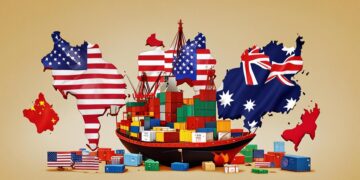How the global economic climate affects investment decisions in Australia

The Global Landscape and Its Effects on Australian Investments
In today’s interconnected world, the dynamics of the global economy have far-reaching consequences, particularly for investors in Australia. As the country positions itself within the broader scope of international market trends, several factors can drive or hinder investment decisions, shaping the financial landscape for both seasoned investors and novices alike. A keen awareness of these elements is essential for anyone looking to make informed investing choices.
Global Supply Chains
Global supply chains are integral to understanding the current investment climate. In recent years, disruptions caused by events like the COVID-19 pandemic and geopolitical tensions have highlighted the vulnerabilities within these systems. For example, the delays in shipping and logistics impacted businesses in Australia, particularly those reliant on imported goods or materials. Industries such as manufacturing and retail were forced to adapt quickly, seeking local sources or alternative suppliers, thereby affecting their cost structures and profit margins. Investors attuned to these shifts may find promising opportunities in businesses that emerge as resilient players in a disrupted market.
Foreign Exchange Rates
Foreign exchange rates represent another crucial aspect of global economic interconnectivity that directly influences investment returns. Fluctuations in currency values can significantly affect the profitability of companies engaged in international trade. For example, if the Australian dollar weakens against the US dollar, Australian exporters may benefit as their goods become cheaper for foreign buyers. However, this also means that import costs rise, affecting businesses that rely heavily on materials sourced from overseas. Savvy investors will need to keep a close eye on currency trends and consider how exchange rate movements may impact companies in which they have invested.
Interest Rates
Central banks wield significant power in shaping economic conditions through interest rates. Changes in monetary policy in key economies, whether it be the Federal Reserve in the United States or the European Central Bank, can ripple through to Australian markets. For instance, if US interest rates rise, it may lead to a stronger US dollar, affecting foreign investment flows and putting pressure on local borrowing rates. This interplay between local and global financial conditions underscores the importance of monitoring global interest rates, as they directly influence the cost of capital and, subsequently, the attractiveness of various investments in Australia.
Considering these elements, Australian investors are increasingly realizing that they cannot remain insulated from global economic shifts. Adopting a broader perspective not only enables them to navigate these complexities effectively but also positions them to capitalize on emerging trends. By understanding the interconnectedness of the global marketplace, investors can make shrewd decisions that safeguard their investments while also positioning themselves to leverage future growth opportunities.
Conclusion
In conclusion, navigating the intricacies of the global economic landscape is paramount for Australian investors. By remaining informed about the nuances of global supply chains, foreign exchange rates, and interest rate policies, they can make better investment decisions. The potential rewards are significant for those willing to broaden their investment horizons, as the interplay of domestic and international factors continues to redefine the parameters of success in Australia’s investment scene.
The Interplay of Global Trends and Local Investments
The investment landscape in Australia is markedly influenced by a mosaic of global trends that shape economic expectations. While local factors undoubtedly play a significant role, the overarching global economic climate shapes investor sentiment and decision-making processes. To evaluate investment opportunities astutely, individuals must consider how international dynamics can impact different sectors within Australia.
Inflation Trends
Global inflation rates rise and fall based on various factors including supply chain issues, commodity prices, and labor costs. When inflation surges in major economies like the United States or the European Union, it often leads to tighter monetary policies, which can ripple through to Australia. A classic example seen during economic recoveries involves rising energy prices due to international demand for crude oil. If inflation increases globally, investors may observe central banks hiking interest rates to cool overheating economies. This economic response can lead to decreased consumer spending, affecting share prices in sectors sensitive to economic cycles, such as retail and hospitality.
Commodity Prices and Australian Exports
Australia’s economy relies heavily on commodity exports, especially during periods of heightened demand from countries like China. Consequently, fluctuations in global commodity prices significantly influence Australian investments. When commodity prices rise, companies engaged in mining and agriculture may enjoy increased revenue, which can attract investors seeking growth. Conversely, a downturn in global commodity demand can lead to reduced profits and therefore cautious investment behavior. For instance, the correlation between iron ore prices and the stock market illustrates this dependency—an increase in global demand often results in a flourishing resources sector, while a slump may dissuade investors.
Geopolitical Events
Geopolitical tensions, whether stemming from trade disputes or international conflicts, create uncertainty that can hinder investment decisions. Australian investors now face the ripple effects of events like Brexit and US-China trade tensions, which can disrupt market confidence. In periods of uncertainty, investors might become risk-averse, opting to hold cash or invest in safe-haven assets. This choice can greatly affect liquidity in markets and influence capital allocation across various sectors. Therefore, keeping abreast of global political developments helps investors assess potential risks to their portfolios.
Strategies for Navigating Global Influence
- Diversification: Investors should consider a diversified portfolio that includes both local and international assets to spread risk.
- Education and Research: Understanding geographic or sector-specific trends can better inform investment choices.
- Focus on Resilience: Seek companies that have demonstrated adaptability and resilience in the face of global challenges.
As the global economic landscape evolves, Australian investors must remain agile and informed. By analyzing how global trends can directly influence local industries, investors can make decisions that not only protect their assets but also position them for future opportunities amidst shifting economic tides.
The Ripple Effect of Interest Rates and Currency Fluctuations
The global economic climate often causes shifts in interest rates that can have profound effects on Australian investments. In a world of interconnected markets, decisions made by the US Federal Reserve or the European Central Bank can influence the Reserve Bank of Australia (RBA) and subsequently local financial conditions. For example, if major economies raise interest rates to combat inflation, it may attract foreign capital seeking higher returns, subsequently increasing the Australian dollar’s value against other currencies.
This appreciation of the Aussie dollar can impact export competitiveness, leading to caution among investors in export-driven sectors. A stronger currency makes Australian goods more expensive abroad, potentially decreasing demand for exports like agricultural products and minerals. If global investors perceive these economic challenges, they may reconsider their positions in Australian equities or fixed income, prompting volatility in the financial markets.
Foreign Direct Investment (FDI) Trends
Foreign direct investment remains crucial for Australia, particularly in areas such as technology, infrastructure, and natural resources. A favorable global economic climate often encourages greater FDI, as international investors seek opportunities in stable economies with robust potential for returns. Conversely, during global downturns or uncertainty, FDI may dwindle as foreign investors adopt a more cautious approach, limiting capital inflow into Australian businesses.
For instance, when the global economy faces challenges—such as the COVID-19 pandemic—investors may prioritize funding domestic stability over international ventures. Australia has shown resilience in attracting FDI, but in a declining global economic landscape, companies might scale back or delay expansion plans, affecting local job creation and innovation. Investors must consider these dynamics when assessing businesses reliant on overseas investment, as they may face increased vulnerability during global economic turbulence.
Emerging Market Impact
Australia is often viewed as a gateway to the Asia-Pacific region, and economic shifts in emerging markets, particularly in Asia, can have direct ramifications for local investments. A slowdown in China, for instance, immediately impacts Australian resource suppliers, as China has been a cornerstone of demand for commodities. Emerging markets may also affect Australian businesses engaged in tourism and trade, as a weakening global economic climate can reduce disposable income for tourists from these regions. While this can threaten local sectors, it can also present new avenues for savvy investors who recognize a shift in consumer behavior.
The Role of Technology and Innovation
In the wake of a rapidly evolving global economic environment, technological advancements and innovation can play a pivotal role in shaping investment decisions. Australia has a burgeoning tech sector, and global shifts towards sustainable practices can create unique investment opportunities. For example, the global push for renewable energy provides Australian investors with avenues to support local clean energy initiatives. By capitalizing on global trends favoring sustainability, investors can position themselves advantageously in sectors likely to thrive amidst changing consumer preferences.
Amidst these dynamic influences, investors are advised to continuously monitor the global landscape and make proactive adjustments to their portfolios, ensuring they are well-positioned to navigate both challenges and opportunities that the interconnected world presents.
Conclusion
In an era where our economies are intricately woven together, understanding how the global economic climate influences investment decisions in Australia is vital for both local and foreign investors. As we’ve explored, fluctuating interest rates and currency values can signal opportunities or threats that impact local markets. This interplay directly affects Australia’s attractiveness for foreign direct investment, which is essential for growth sectors like technology and infrastructure.
Moreover, the health of emerging markets, particularly in Asia, is crucial for Australian exporters and businesses reliant on tourism. As shifts occur in these markets, they invariably surface as challenges or opportunities for Australian entities. The recent global emphasis on sustainable practices and technology has opened new avenues for investment, enabling Australian investors to pivot towards industries poised for growth amid change.
As we move forward in this interconnected world, the key takeaway for investors is to maintain a vigilant and adaptive approach. The lessons gleaned from past economic cycles affirm that by being proactive—leaning into emerging trends, responding to international shifts, and investing in innovation—Australia can continue to thrive as a stable investment hub. In essence, navigating these global currents will require both resilience and foresight, ensuring that Australian investments remain robust and well-prepared for whatever lies ahead.

James Carter is a financial writer and advisor with expertise in economics, personal finance, and investment strategies. With years of experience helping individuals and businesses make complex financial decisions, James offers practical insight and analysis. His goal is to give readers the knowledge they need to achieve financial success.






